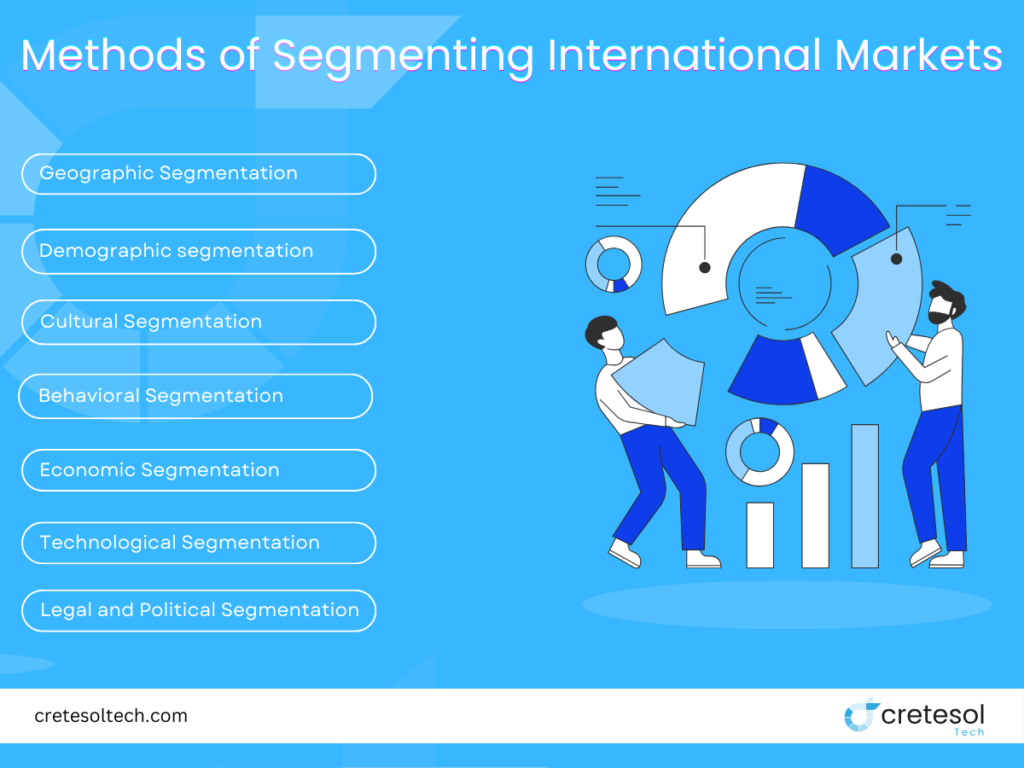International market segmentation and positioning are two very important steps to achieve in the international market research process. International market segmentation is a marketing approach in which you divide your potential customers in international markets into different groups with needs or characteristics. International market positioning, on the other hand, involves a strategic approach by a business to produce a distinct identity or image for its services or products in the minds of global consumers across different markets.
1. Understanding International Market Segmentation
Segmentation makes it convenient for businesses or brands to comprehend the diverse nature of global markets deeply. It is like organizing your wardrobe. You just know what to pick and from where to pick your outfit for a specific event. Just like that, in international marketing or digital marketing, segmentation works in the same manner. Instead of sending the same message to everyone, you divide your audience into distinct groups based on their interests, behaviors, or demographics.
Market segmentation allows you to tailor your messaging to each group’s specific needs and preferences, making your marketing efforts more effective and efficient. A target audience can be segmented based on various factors that include demographics, psychographic profiles, economic conditions, or even behavioral traits.
Segmentation offers the following benefits. Here’s a more detailed table with the benefits of segmentation:
| Benefits of Segmentation | Description |
| Identify Lucrative Markets | By analyzing different market segments, businesses can pinpoint the most profitable markets or niches. This helps in prioritizing efforts on segments with the highest potential for growth and profitability. |
| Optimize Resource Allocation | Segmentation allows companies to allocate their resources more efficiently. By focusing on specific segments, businesses can ensure that their time, budget, and manpower are directed toward areas that yield the highest returns. |
| Develop Focused Marketing Messages | Segmentation enables the creation of tailored marketing messages that speak directly to the needs, desires, and pain points of each specific segment. This increases the effectiveness of marketing campaigns and enhances customer engagement. |
| Produce Resonant Products | Understanding the unique characteristics and preferences of different segments allows businesses to design and produce products that resonate well with targeted consumer groups. This alignment with consumer needs can lead to higher satisfaction and loyalty. |
All of these benefits of market segmentation give you a competitive advantage and ultimately steer you toward successful international marketing endeavors.
2. Methods of Segmenting International Markets
There is more than one method when it comes to international market segmentation and positioning. Let’s go through the different methods of segmenting international markets.

Geographic Segmentation:
Geographic segmentation involves dividing the market based on regions, countries, cities, or climate zones. This type of segmentation helps businesses customize their products and offerings to match the preferences, needs, and conditions of people in different geographical areas. For instance, a company might offer different products in urban areas compared to rural areas, or design marketing campaigns that cater to the climate and cultural practices of a specific region. By tailoring their approach to specific geographic segments, businesses can better meet local demands and enhance customer satisfaction.
Demographic segmentation:
In this method, segmentation is based on the following factors:
- Age
- Gender
- Income
- Education
- Family Size
Marketers can understand the consumers’ buying preferences and habits by implementing demographic segmentation in their international marketing strategies.
Cultural Segmentation:
Cultural segmentation is based on shared cultural practices and values, enabling businesses to target groups that share similar customs, traditions, and beliefs. This approach also involves dividing groups by the languages they speak, which can significantly impact communication strategies, marketing messages, and product offerings. By understanding cultural nuances, companies can create more personalized and effective marketing campaigns.
Behavioral Segmentation:
Behavioral segmentation focuses on the consumer’s decision-making patterns, brand loyalty, usage rates, and benefits sought. This method allows companies to target customers based on their purchasing behaviors and product usage patterns. By analyzing how consumers interact with products and services, marketers can tailor their strategies to emphasize specific features, benefits, or experiences that resonate with different consumer segments, enhancing customer satisfaction and retention.
Economic Segmentation:
Economic segmentation divides markets based on consumers’ purchasing power, income levels, and economic conditions. This approach helps businesses position their products more effectively by aligning pricing strategies with the financial capabilities of each segment. By understanding the economic environment of their target markets, companies can offer products and services that meet the needs and budgets of different consumer groups, ensuring better market penetration and customer satisfaction.
Technological Segmentation:
Technological segmentation involves grouping consumers based on their internet and technology adoption rates. This method segments individuals by their familiarity and comfort with technology, allowing businesses to tailor their marketing strategies and product offerings accordingly. By understanding the technological preferences and capabilities of their target audience, companies can develop more relevant and accessible products, services, and marketing campaigns that cater to tech-savvy consumers.
Legal and Political Segmentation:
Legal and political segmentation involves grouping markets according to the regulatory environment and legal requirements. This method also segments markets based on the level of political stability and governance. By understanding the legal and political landscape of their target markets, businesses can navigate regulatory challenges, ensure compliance, and mitigate risks. This approach enables companies to adapt their strategies to different legal and political contexts, ensuring smoother market entry and operation.
3. Challenges in International Market Segmentation
In international market segmentation and positioning, marketers frequently face many challenges during the process of segmentation and positioning.
- Companies cannot be all things to all people because buyers differ in their needs, wants, and demands.
- Segmenting international markets is necessary, just as it is with consumer markets and B2B markets.
- International market segmentation and positioning add complications, including differences in cultural, economic, and political environments across countries.
- Due to cultural, economic, and political differences, consumers in international markets are more diverse in character than those in domestic markets.
- The range of income levels, populations, and the diversity of lifestyles in international markets are significantly greater than in domestic markets.
- A single marketing strategy for all segments is often ineffective.
- Obtaining consumer insights for international market segmentation is challenging due to the complexity and diversity of international markets.
- Effective international market segmentation and positioning requires an in-depth understanding of various market dynamics and consumer behaviors.
4. Developing Effective Positioning Strategies
Positioning for Competitive Advantages involves more than just selecting which market segments a company will target; it also entails determining the specific positions it aims to occupy within those segments. A product’s position refers to its place in consumers’ minds relative to competing brands, defined by how consumers perceive its unique benefits and differentiation on key attributes. This process of international market segmentation and positioning entails embedding the brand’s distinct advantages deeply into consumers’ perceptions.
Consumers face an overwhelming amount of information about products, leading them to categorize and mentally position products to simplify their purchasing decisions. Therefore, a product’s position encompasses the intricate set of perceptions, impressions, and emotions that consumers associate with it compared to competitors.
While customers may position products independently, marketers strive to deliberately shape their product’s position. They carefully plan positions that offer the greatest advantage in selected target markets and develop tailored marketing strategies to reinforce these planned positions. Effective international market segmentation and positioning strategies aim to differentiate the brand by crafting a unique bundle of benefits that resonate with a significant portion of the target segment.
The ultimate goal of positioning is to establish the brand in consumers’ minds to maximize benefits for the firm. Successful positioning results in the creation of a customer-focused value proposition that aligns with consumers’ needs and preferences.
The task of positioning encompasses several critical steps:
- Conducting competitive analysis in international markets to identify potential competitive advantages to build a position. Cretesoltech uses advanced tools and methodologies to ensure a thorough and accurate analysis.
- Selecting the most appropriate advantages and choosing an overarching positioning strategy. Our experts at Cretesoltech help you pinpoint the most promising opportunities to leverage for maximum impact.
- Effectively communicating and delivering this strategy to the market. Cretesoltech ensures your strategy is clearly conveyed and successfully implemented to resonate with your target audience.
5. Tools and Techniques for Market Analysis
- Market Research
- Data Analytics
- Consumer Feedback
| Tool/Technique | Description |
| Market Research | Conducting comprehensive market research helps businesses gather insights into consumer preferences, market trends, and competitor strategies. |
| Data Analytics | Leveraging data analytics tools enables businesses to analyze consumer behavior patterns, identify market opportunities, and optimize marketing strategies. |
| Consumer Feedback | Gathering direct feedback from consumers through surveys, focus groups, and social media channels provides valuable insights for refining market segmentation and positioning strategies. |
Conclusion
Effective international market segmentation and positioning strategies are pivotal for businesses looking to expand their global footprint. By understanding diverse market segments, overcoming challenges, and implementing tailored positioning strategies, businesses can enhance their competitiveness and achieve sustainable growth in international markets.
For expert assistance in developing effective international market segmentation and positioning strategies tailored to your business needs, contact Cretesol Tech. Our team is here to help your business achieve success.
FAQs
What are the primary methods of international market segmentation?
International market segmentation methods include geographic, demographic, psychographic, and behavioral segmentation, cultural segmentation, economic segmentation, technological segmentation, and legal and political segmentation.
How can businesses effectively position their products in global markets?
Businesses can effectively position their products by defining a unique value proposition, conducting thorough market analysis, understanding consumer preferences, and communicating their strengths effectively to target segments.
What are the challenges of segmenting international markets, and how can they be overcome?
Challenges include cultural variations, economic disparities, and complex consumer behaviors. Overcoming these challenges requires localized market research, adaptation of marketing strategies, and continuous monitoring of market dynamics.

 United Arab Emirates
United Arab Emirates